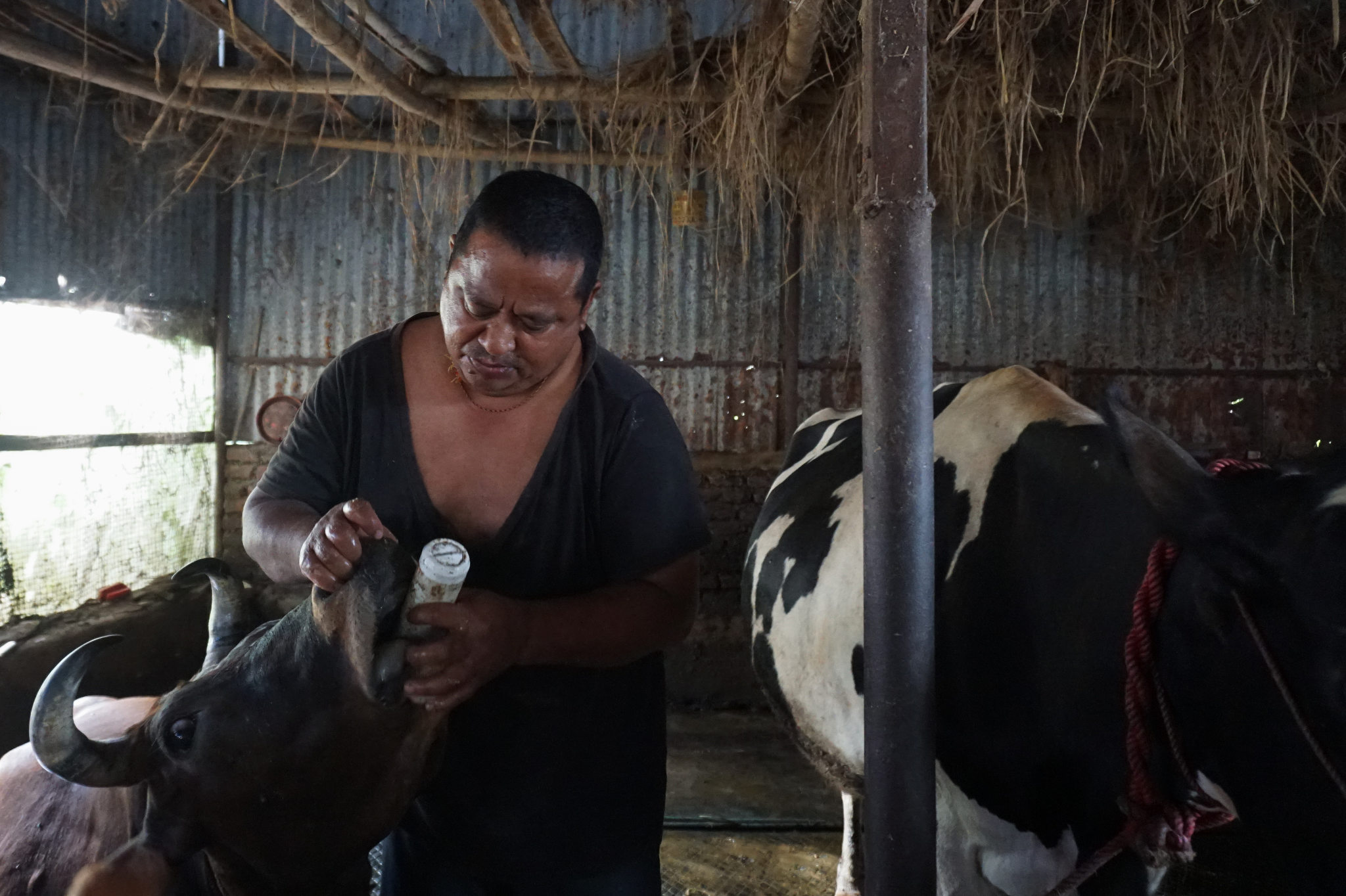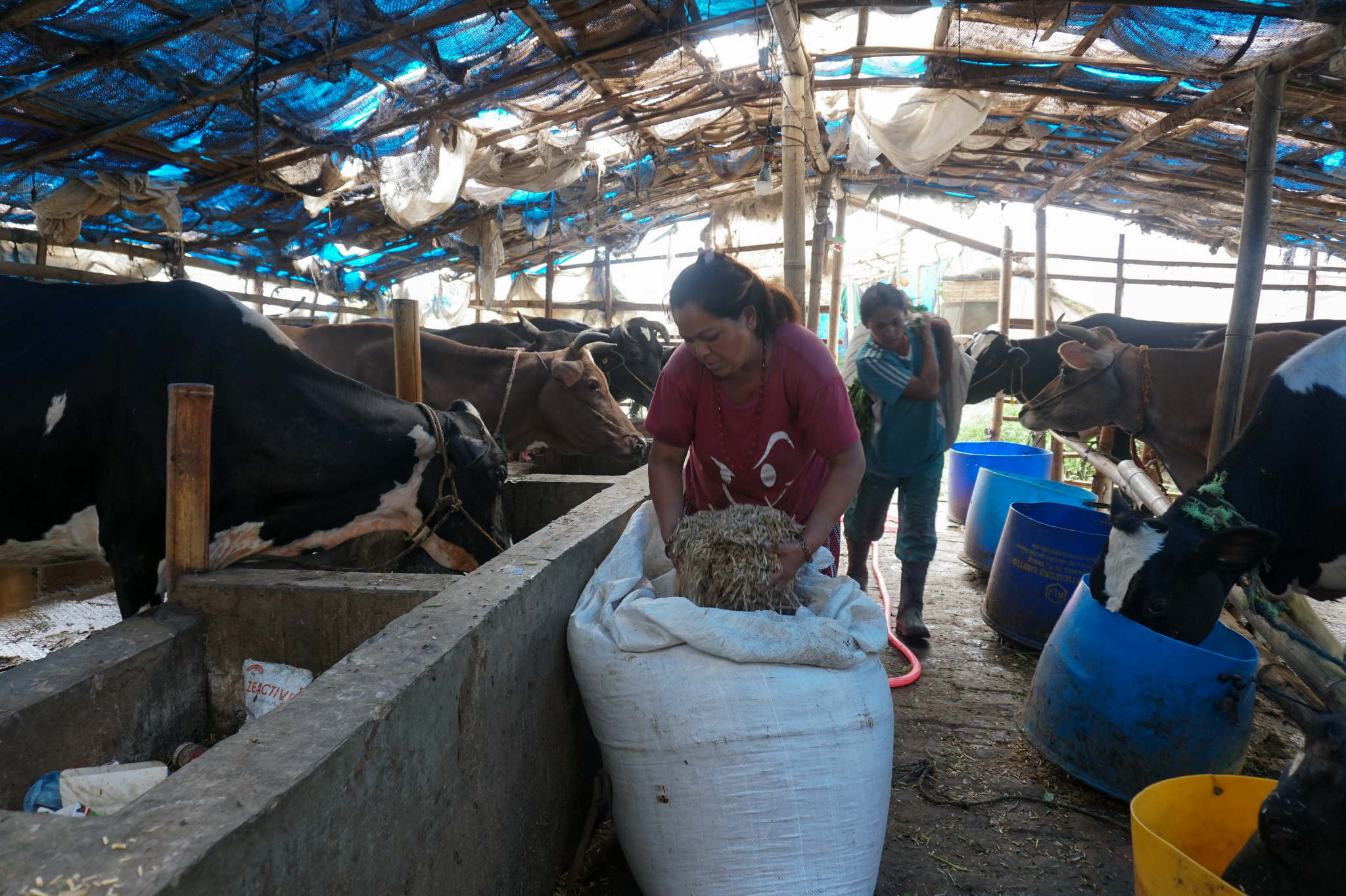
Sunita Neupane, GPJ Nepal
Gop Bahadur Thakuri attends to his cows on his farm in Bagmati province.
KATHMANDU, NEPAL — Since June, Gop Bahadur Thakuri, a cattle farmer from the Chandragiri municipality, has lost four cows to lumpy skin disease. Of his 22 cows, 10 were infected within days. The farmer struggled to take care of the animals suffering from a disease about which he had very little knowledge.
In early June, one of Thakuri’s cows developed a fever of 107 degrees Fahrenheit — the normal body temperature of a healthy cow is around 101 F. The next day, the cow developed giant blisters on its body. Hours later, the blisters started cracking, leaving the animal’s body mottled with giant, pus-filled wounds. Before Thakuri could even figure out what was happening, the animal couldn’t stand anymore and stopped eating or drinking. Days later the previously healthy cow, which had just given birth, was dead. Other cows began showing similar symptoms around the same time, and within seven to eight days of coming down with the virus three more cows died on Thakuri’s farm.
While Thakuri had heard of the lumpy skin disease virus from television news, he didn’t know much about how to treat it. “I don’t know where this disease came from,” he says. So, he turned to YouTube and started watching videos to learn how to take care of animals affected by the virus.






Thakuri now bathes all his cows, including the ones not infected, in alum water every day. He sprays the barn regularly with a mix of phenyl and water to repel flies and mosquitoes. To drive away insects, he lights a fire and smokes the shed regularly.
From YouTube, Thakuri has learned how to drain the lesions that appear on the animals’ skin. Afterward, he cleans the affected areas with povidone-iodine. For the cows that have developed fever, Thakuri gives paracetamols, a type of painkiller, and makes sure they drink a lot of water. The sick cows are fed soft grass, water mixed with jaggery, and vitamins.
The lumpy skin disease virus, first discovered in Nepal in 2020, has now taken alarming form and infected thousands of cattle. Over 50,000 cattle have died of the virus so far in the country.
What is the lumpy skin disease virus?
The lumpy skin disease virus belongs to the poxviridae family and the capripoxvirus genus. It is spread through the bites of carriers like mosquitoes, maggots, weevils and other insects that feed on animal blood. Infected animals can spread the virus to healthy animals through physical contact.



With an animal mortality rate of 3.8%, the economic loss has amounted to more than 27 billion Nepali rupees (over 203 million United States dollars), says Dr. Manoj Kumar Shahi, spokesperson for the Nepal Veterinary Council. “If this disease is not treated and controlled in a timely manner, it appears that approximately 2,526,000 animals will be infected, 100,000 animals will die, and there will be an economic loss of about 126 billion rupees [947.6 million dollars].”
Before the disease hit his farm, Thakuri used to sell 200 liters of milk each day. Now the amount of milk he sells has been reduced to 100 liters.
Current situation in Nepal
The earliest recorded occurrence of the disease dates back to a 1929 epidemic in Zambia. Almost 90 years later, the disease traveled to Bangladesh, China and India. In Nepal, the first cases of the lumpy skin disease virus in cattle were spotted in June 2020, in cows in the Morang district. However, for the next two years, the spread of the disease was slow, and casualties weren’t very high.
Before the infection started soaring rapidly this year, the government had identified the virus and issued guidelines on how to treat animals affected by it, says Dr. Chandra Dhakal, information officer at the Department of Livestock Services under the Ministry of Agriculture and Livestock Development.
The recent outbreak, however, has witnessed a rapid spread of the disease and an alarming number of cattle deaths. The outbreak, which began in some districts of Koshi province between March and April, gradually spread to other provinces and is now across all seven of Nepal’s provinces and each of the country’s 77 districts. The Koshi, Karnali and Sudurpaschim provinces have been the worst hit. Vaccinations for livestock began in May, and in July the prime minister ordered the concerned departments to take necessary steps to provide affected farmers with compensation.
Dhakal claims that the rate of infection has now decreased. However, Dr. Swoyam Prakash Shrestha, director of the National Animal Science Research Institute under the Nepal Agricultural Research Council, an autonomous organization, believes that the disease is still on the rise.
Shrestha adds that Nepal also doesn’t have enough veterinarians to treat an outbreak of this scale. He says that while international standards call for one doctor per 500 animals, Nepal has one qualified veterinarian per 12,000 cattle.
Ram Krishna Khatiwada, president of the Nepal Veterinary Association, a professional organization of veterinarians, says that the Department of Livestock Services is concealing the true number of infected and dead animals to cover its weakness. However, Dhakal denies the allegation.
How is the disease transmitted?
The disease can spread easily within herds, where physical contact is frequent.
“Often farmers end up keeping different species of animals together. There are common pastures that infected and healthy animals are being grazed upon as well,” Dhakal says. “Humans can also be vectors. When you travel to a disease-spreading area, you often carry insects and worms back with you, stuck on your clothes or shoes. And then if you come near healthy cattle, it leads to them getting infected.”
Feeding from the same utensils and consuming water from the same source can also spread the disease.



The incubation period of the virus is between seven and 12 days, after which symptoms start to appear. It can take between 10 and 15 days to completely recover from an infection. Effects of the infection, studies have suggested, may linger for six months in some cases.
Symptoms of lumpy skin disease virus
Initially, a fever of more than 104 F and dehydration occur. On the skin, hard, round blisters of between 1 centimeter and 5 centimeters appear. The animal then becomes lethargic and weak and does not eat.
In cases of quick recoveries, blisters disappear by themselves. However, in other cases they burst, leaving open wounds all over the animal’s body. Flies and other insects that come in contact with these open wounds aggravate the disease.
Other visible symptoms are excessive discharge from the eyes and nose, unusual amounts of drooling and swollen lymph nodes, Dhakal says.
“The virus might lead to miscarriage in pregnant animals and also periods of infertility where the female animals can’t conceive. It can also lead to a 30% to 40% reduction in milk production,” Shahi adds.






Treatment and prevention methods
Khatiwada says there is no option other than vaccination to prevent the lumpy skin disease virus. “Infected animals should not be vaccinated. Recovered animals should be vaccinated after one year.”
He adds that milk from an infected animal shouldn’t be consumed for 14 days after administering antibiotics to the animal.
The disease can be controlled through herd immunity, in this case when more than 80% of an animal population is vaccinated against the virus. “This is the only way we can control the spread of the disease,” Shahi says.
The infection cycle usually lasts between 10 and 12 days. Dhakal says if an animal has not recovered by then, chances are it might not survive. He suggests infected animals be quarantined and fed plenty of hay, or soft grass, as well as fluids, such as jaggery water.
Animals that are very weak and can’t eat can be administered saline by a trained veterinary technician, he adds. Injections with paracetamols and other painkillers, to reduce pain and fever, can also be administered by trained professionals.
Dhakal adds that superstitions harbored by cattle owners can make things worse. “Many animals are dying because despite running a fever, bulls are being used to plough fields. There’s also a false belief that they should not be given water when they have fever, leading to the animal’s death,” Dhakal says.
Helpline
The Nepal Veterinary Association operates a toll-free phone number: 1159.
How to Get Vaccinations
In order to vaccinate cattle, farmers should contact their nearest municipal ward office for information about the closest vaccination facility. The vaccine should be administered only by a qualified technician. The farmer must buy the vaccine; one shot costs between 220 and 240 rupees (1.65 and 1.80 dollars).
Sunita Neupane is a Global Press Journal reporter based in Nepal.
TRANSLATION NOTE
Sunil Pokhrel, GPJ, translated this article from Nepali.







